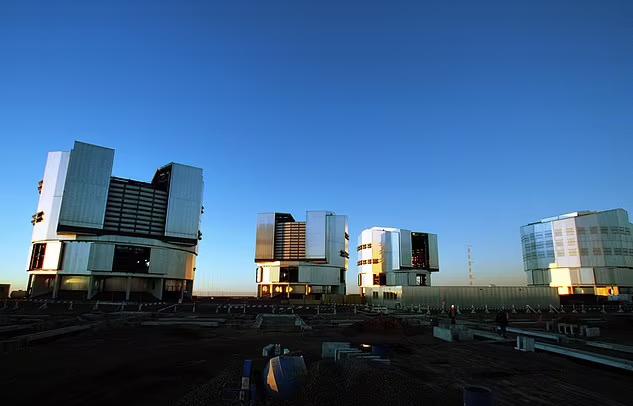The European Southern Observatory (ESO) released "the deepest and clearest picture to date" of the region around the Supermassive Black Hole in the Milky Way on December 14, showing several stars moving at breakneck speed in orbit around the Sagittarius A* black hole. Astronomy and Astrophysics, published on the same day, published two papers by an international team of experts detailing this achievement.

The Very Large Telescope (VLT) in the Atacama Desert in northern Chile.
The stunning new photos were reportedly taken earlier this year, when researchers at the European Southern Observatory used the Very Large Telescope (VLT) in the Atacama Desert in northern Chile to take the photos, which were magnified 20 times more than before.
The researchers also discovered a never-before-seen star close to a black hole, called S300, and provided the most accurate estimate of the mass of the black hole at the center of the Milky Way to date — 4.3 million times the mass of the Sun.
This star chart shows the position of view of Sagittarius A*. Black holes are marked with red circles in sagittarius. This star map shows most of the stars that are visible to the unoccupied eye under good conditions.
Reinhard Genzel, director of the Max Planck Institute for Extraterrestrial Physics (MPE) in Jiaxing, Germany, said the best way to answer these questions is to track stars close to the orbit of supermassive black holes, just how massive Sagittarius A* is, whether it rotates, and whether the surrounding stars operate exactly as predicted by Einstein's general theory of general relativity.
He said the new photos show that astronomers have done this with far more precision than in the past.
This visible-light wide-angle star chart shows the rich nebula of Sagittarius in the direction of the center of the Milky Way. The entire image is filled with a large number of stars, but more stars are still hidden behind dust clouds and can only be seen in infrared images.
It is reported that black holes are a region of time and space with huge gravitational pull, and even light cannot escape from them. As a strong source of gravity, the black hole will engulf the surrounding dust and gas.
Due to the strong gravitational pull of the Sagittarius A* black hole, stars in the Milky Way, including our Sun, orbit it.
These stars orbit black holes trillions of miles away, but if they get too close, they are swallowed up.
Fortunately, Earth is about 27,000 light-years away from Sagittarius A*, or more than 150 trillion miles.
Images taken by the European Southern Observatory on March 30, 2021, show small orange patches of stars around the black hole Sagittarius A* at the center of the Milky Way.
The research team, known as the GRAVITY collaboration, has developed a new technique that has resulted in the deepest, sharpest image of the galactic center to date.
The telescopes that make up the VLT can work together to form a giant "interferometer" VLTI, which allows the image to be filtered out of any unwanted occlusion.
Julia Stadler, a researcher at the Max Planck Institute for Astrophysics, said VLTI offers incredible spatial resolution, and with new images, astronomers are deeper than ever deeper into the center of the Milky Way than ever before, and the team was "shocked" by the number of details they have, as well as the movement and number of stars around the black hole they reveal.
With the latest observations made between March and July 2021, the research team focused on making precise measurements of stars close to black holes.
Images of stars around Sagittarius A* taken on May 29 this year. S29 is one of the particularly bright stars near the center of this image, the second from bottom to top, closest to a black hole at the end of May 2021.
This includes a previously unseen star named S300, and a star called S29, which most recently approached the black hole at the end of May 2021.
S29 "brushed shoulders" with the black hole at a distance of just 8 billion miles (13 billion kilometers), about 90 times the sun-Earth distance, and reached an astonishing speed of 5430 miles per second.
The movement of stars at different points in time at the center of the Milky Way earlier this year.
Never before has the astronomical community observed other stars passing through a black hole at such close distances, or orbiting a black hole at such a fast speed.
The researchers also managed to fine-tune the distance from Earth to Sagittarius A* to 27,000 light-years away. Years later, an update to the VLT facility will further boost the sensitivity of the technology to reveal fainter stars and even closer to black holes.
Images taken on June 24, 2021, showed changes in the positions of stars around Sagittarius A*.
Images of the stars around Sagittarius A* taken on July 27 this year.
The team's goal is to eventually find stars so close to observe how their orbits are affected by the black hole's rotation.
The European Space Agency's imminent construction of the Extremely Large Telescope (ELT) in Chile's Atacama Desert will further enable the research team to measure the velocities of these stars with very high precision.
Text/Nandu reporter Chen Lin